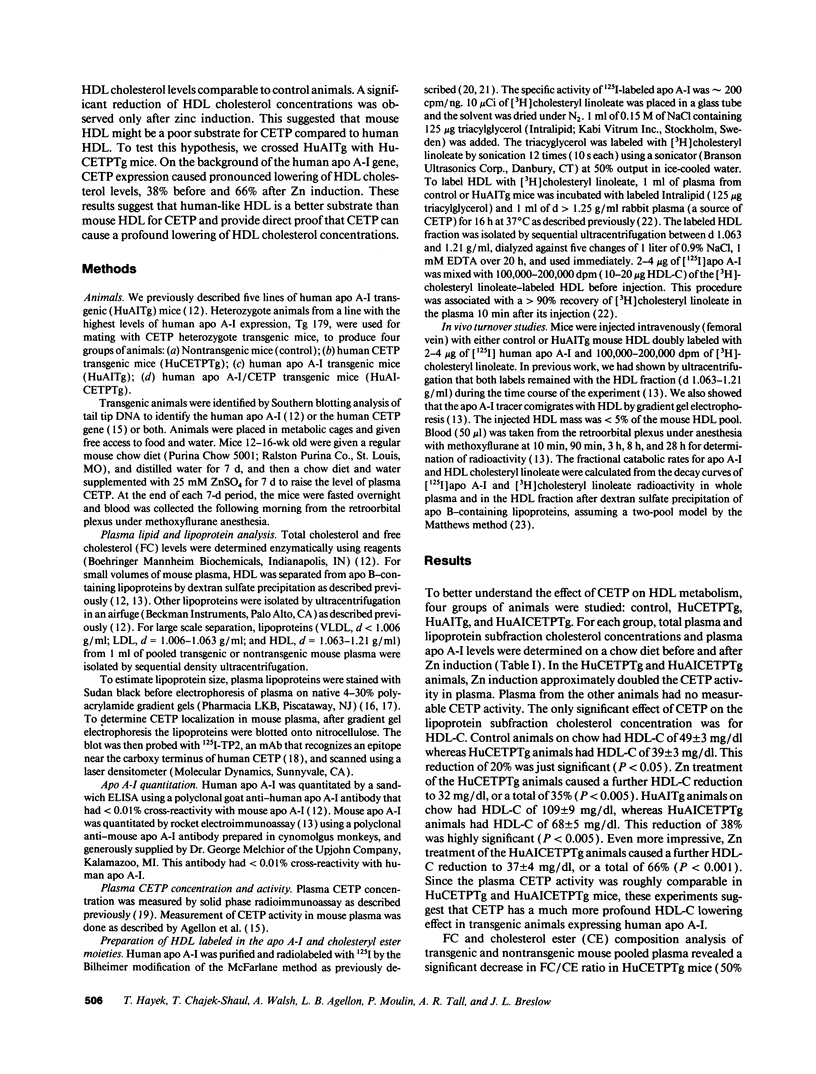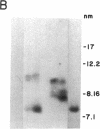Abstract
We have previously described two transgenic mouse lines, one heterozygous for the human apo A-I gene and the other heterozygous for a human cholesteryl ester transfer protein (CETP) minigene driven by the mouse metallothionein-I gene promoter. In the current study, these two lines were crossed producing control, HuCETPTg, HuAITg, and HuAICETPTg mice to study the influence of CETP on HDL cholesterol levels, particle size distribution, and metabolism in animals with mouse and human-like HDL. In the HuCETPTg and HuAICETPTg animals, zinc induction approximately doubled plasma CETP activity, with no activity in plasma from the control and HuAITg animals. The only significant effect of CETP on lipoprotein subfraction cholesterol concentrations was for HDL-C. Compared to control animals, HuCETPTg animals had lower HDL-C, 20% before and 35% after Zn induction, and compared to HuAITg animals, HuAICETPTg animals had lower HDL-C, 35% before and 66% after Zn induction. Control and HuCETPTg HDL consist primarily of a single size population with a mean diameter of 10.00 +/- 0.10 nm and 9.71 +/- 0.05 nm, respectively. HuAITg HDL consists primarily of three distinct HDL size subpopulations with peak diameters of 10.35 +/- 0.08 nm, 8.80 +/- 0.06 nm, 7.40 +/- 0.10 nm, and HuAICETPTg HDL also consists primarily of three distinct HDL size subpopulations with peak diameters of 9.87 +/- 0.05 nm, 8.60 +/- 0.10 nm, 7.30 +/- 0.15 nm before, and 9.71 +/- 0.08 nm, 8.50 +/- 0.11 nm, 7.27 +/- 0.15 nm after zinc induction, respectively. Western blotting analysis of nondenaturing gradient gels of plasma with a monoclonal antibody to CETP indicated that in HuCETPTg and HuAICETPTg mice, 22 and 100%, respectively, of the CETP was HDL associated. Turnover studies with HDL doubly labeled with 125I apo A-I and 3H cholesteryl linoleate indicated that the CETP-induced fall in HDL-C was associated with increased HDL-cholesterol ester fractional catabolic rate in both the absence and presence of human apo A-I, suggesting CETP-mediated transfer of HDL-cholesterol ester to apo B-containing lipoproteins. In summary, these studies suggest that CETP has a much more profound effect on HDL cholesterol levels in transgenic animals expressing human apo A-I. This may be due to an enhanced interaction of CETP with human compared to mouse apo A-I or to the HDL particles they produce.
Full text
PDF





Images in this article
Selected References
These references are in PubMed. This may not be the complete list of references from this article.
- Agellon L. B., Walsh A., Hayek T., Moulin P., Jiang X. C., Shelanski S. A., Breslow J. L., Tall A. R. Reduced high density lipoprotein cholesterol in human cholesteryl ester transfer protein transgenic mice. J Biol Chem. 1991 Jun 15;266(17):10796–10801. [PubMed] [Google Scholar]
- Barter P. J., Jones M. E. Kinetic studies of the transfer of esterified cholesterol between human plasma low and high density lipoproteins. J Lipid Res. 1980 Feb;21(2):238–249. [PubMed] [Google Scholar]
- Bilheimer D. W., Eisenberg S., Levy R. I. The metabolism of very low density lipoprotein proteins. I. Preliminary in vitro and in vivo observations. Biochim Biophys Acta. 1972 Feb 21;260(2):212–221. doi: 10.1016/0005-2760(72)90034-3. [DOI] [PubMed] [Google Scholar]
- Blanche P. J., Gong E. L., Forte T. M., Nichols A. V. Characterization of human high-density lipoproteins by gradient gel electrophoresis. Biochim Biophys Acta. 1981 Sep 24;665(3):408–419. doi: 10.1016/0005-2760(81)90253-8. [DOI] [PubMed] [Google Scholar]
- Brown M. L., Inazu A., Hesler C. B., Agellon L. B., Mann C., Whitlock M. E., Marcel Y. L., Milne R. W., Koizumi J., Mabuchi H. Molecular basis of lipid transfer protein deficiency in a family with increased high-density lipoproteins. Nature. 1989 Nov 23;342(6248):448–451. doi: 10.1038/342448a0. [DOI] [PubMed] [Google Scholar]
- Castelli W. P., Garrison R. J., Wilson P. W., Abbott R. D., Kalousdian S., Kannel W. B. Incidence of coronary heart disease and lipoprotein cholesterol levels. The Framingham Study. JAMA. 1986 Nov 28;256(20):2835–2838. [PubMed] [Google Scholar]
- Chajek-Shaul T., Hayek T., Walsh A., Breslow J. L. Expression of the human apolipoprotein A-I gene in transgenic mice alters high density lipoprotein (HDL) particle size distribution and diminishes selective uptake of HDL cholesteryl esters. Proc Natl Acad Sci U S A. 1991 Aug 1;88(15):6731–6735. doi: 10.1073/pnas.88.15.6731. [DOI] [PMC free article] [PubMed] [Google Scholar]
- Eisenberg S. High density lipoprotein metabolism. J Lipid Res. 1984 Oct;25(10):1017–1058. [PubMed] [Google Scholar]
- Eisenberg S., Oschry Y., Zimmerman J. Intravascular metabolism of the cholesteryl ester moiety of rat plasma lipoproteins. J Lipid Res. 1984 Feb;25(2):121–128. [PubMed] [Google Scholar]
- Glass C., Pittman R. C., Civen M., Steinberg D. Uptake of high-density lipoprotein-associated apoprotein A-I and cholesterol esters by 16 tissues of the rat in vivo and by adrenal cells and hepatocytes in vitro. J Biol Chem. 1985 Jan 25;260(2):744–750. [PubMed] [Google Scholar]
- Glass C., Pittman R. C., Weinstein D. B., Steinberg D. Dissociation of tissue uptake of cholesterol ester from that of apoprotein A-I of rat plasma high density lipoprotein: selective delivery of cholesterol ester to liver, adrenal, and gonad. Proc Natl Acad Sci U S A. 1983 Sep;80(17):5435–5439. doi: 10.1073/pnas.80.17.5435. [DOI] [PMC free article] [PubMed] [Google Scholar]
- Gordon D. J., Rifkind B. M. High-density lipoprotein--the clinical implications of recent studies. N Engl J Med. 1989 Nov 9;321(19):1311–1316. doi: 10.1056/NEJM198911093211907. [DOI] [PubMed] [Google Scholar]
- Ha Y. C., Chang L. B., Barter P. J. Effects of injecting exogenous lipid transfer protein into rats. Biochim Biophys Acta. 1985 Feb 8;833(2):203–210. doi: 10.1016/0005-2760(85)90191-2. [DOI] [PubMed] [Google Scholar]
- Inazu A., Brown M. L., Hesler C. B., Agellon L. B., Koizumi J., Takata K., Maruhama Y., Mabuchi H., Tall A. R. Increased high-density lipoprotein levels caused by a common cholesteryl-ester transfer protein gene mutation. N Engl J Med. 1990 Nov 1;323(18):1234–1238. doi: 10.1056/NEJM199011013231803. [DOI] [PubMed] [Google Scholar]
- MATTHEWS C. M. The theory of tracer experiments with 131I-labelled plasma proteins. Phys Med Biol. 1957 Jul;2(1):36–53. doi: 10.1088/0031-9155/2/1/305. [DOI] [PubMed] [Google Scholar]
- Marcel Y. L., McPherson R., Hogue M., Czarnecka H., Zawadzki Z., Weech P. K., Whitlock M. E., Tall A. R., Milne R. W. Distribution and concentration of cholesteryl ester transfer protein in plasma of normolipemic subjects. J Clin Invest. 1990 Jan;85(1):10–17. doi: 10.1172/JCI114397. [DOI] [PMC free article] [PubMed] [Google Scholar]
- Miller N. E. Associations of high-density lipoprotein subclasses and apolipoproteins with ischemic heart disease and coronary atherosclerosis. Am Heart J. 1987 Feb;113(2 Pt 2):589–597. doi: 10.1016/0002-8703(87)90638-7. [DOI] [PubMed] [Google Scholar]
- Reichl D., Miller N. E. Pathophysiology of reverse cholesterol transport. Insights from inherited disorders of lipoprotein metabolism. Arteriosclerosis. 1989 Nov-Dec;9(6):785–797. doi: 10.1161/01.atv.9.6.785. [DOI] [PubMed] [Google Scholar]
- Rubin E. M., Ishida B. Y., Clift S. M., Krauss R. M. Expression of human apolipoprotein A-I in transgenic mice results in reduced plasma levels of murine apolipoprotein A-I and the appearance of two new high density lipoprotein size subclasses. Proc Natl Acad Sci U S A. 1991 Jan 15;88(2):434–438. doi: 10.1073/pnas.88.2.434. [DOI] [PMC free article] [PubMed] [Google Scholar]
- Stein Y., Dabach Y., Hollander G., Halperin G., Stein O. Metabolism of HDL-cholesteryl ester in the rat, studied with a nonhydrolyzable analog, cholesteryl linoleyl ether. Biochim Biophys Acta. 1983 Jun 16;752(1):98–105. doi: 10.1016/0005-2760(83)90237-0. [DOI] [PubMed] [Google Scholar]
- Swenson T. L., Hesler C. B., Brown M. L., Quinet E., Trotta P. P., Haslanger M. F., Gaeta F. C., Marcel Y. L., Milne R. W., Tall A. R. Mechanism of cholesteryl ester transfer protein inhibition by a neutralizing monoclonal antibody and mapping of the monoclonal antibody epitope. J Biol Chem. 1989 Aug 25;264(24):14318–14326. [PubMed] [Google Scholar]
- Tall A. R. Plasma high density lipoproteins. Metabolism and relationship to atherogenesis. J Clin Invest. 1990 Aug;86(2):379–384. doi: 10.1172/JCI114722. [DOI] [PMC free article] [PubMed] [Google Scholar]
- Walsh A., Ito Y., Breslow J. L. High levels of human apolipoprotein A-I in transgenic mice result in increased plasma levels of small high density lipoprotein (HDL) particles comparable to human HDL3. J Biol Chem. 1989 Apr 15;264(11):6488–6494. [PubMed] [Google Scholar]
- Whitlock M. E., Swenson T. L., Ramakrishnan R., Leonard M. T., Marcel Y. L., Milne R. W., Tall A. R. Monoclonal antibody inhibition of cholesteryl ester transfer protein activity in the rabbit. Effects on lipoprotein composition and high density lipoprotein cholesteryl ester metabolism. J Clin Invest. 1989 Jul;84(1):129–137. doi: 10.1172/JCI114132. [DOI] [PMC free article] [PubMed] [Google Scholar]
- Yamashita S., Sprecher D. L., Sakai N., Matsuzawa Y., Tarui S., Hui D. Y. Accumulation of apolipoprotein E-rich high density lipoproteins in hyperalphalipoproteinemic human subjects with plasma cholesteryl ester transfer protein deficiency. J Clin Invest. 1990 Sep;86(3):688–695. doi: 10.1172/JCI114764. [DOI] [PMC free article] [PubMed] [Google Scholar]




